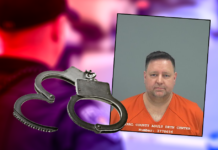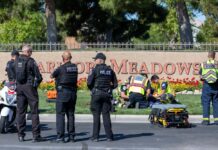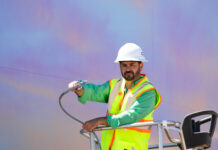If you think 45 trains a day passing through a town the size of Maricopa is a lot, just wait. According to Union Pacific Railroad, demand along its Sunset Route through Maricopa continues to increase and the number of trains passing through the city is likely to be 86 per day by 2016.
Union Pacific, which is required to obtain federal, state and local approvals for just about everything it does, is proceeding diligently to meet the increasing demand by converting its Sunset Route to a double track system.
Maricopa, along with Casa Grande, Eloy and Pinal County, “is currently working on an agreement with (the railroad) regarding the double track project,” said Brent Billingsley, the city’s transportation director.
He added that when and if an agreement is reached between all parties, a plan will be brought before the city council.
To update local business leaders and government officials on its double-tracking plans in Arizona, the railroad gave a presentation entitled “Expanding Capacity for a Growing Economy” last week at a Pinal Partnership meeting at Central Arizona College in Coolidge. More than 250 members and guests attended, including Mayor Kelly Anderson, Interim City Manager Roger Kolman and other city officials.
The term “double tracking” means just what it suggests: two tracks, parallel to each other. Theoretically, two tracks would allow a railroad to move trains in both directions at once. In practice, however, and in conjunction with large switching yards – such as the one planned for the Red Rock area near Picacho Peak and I-10 – it provides more flexibility and improves the company’s ability to adhere to tight deadlines imposed by customers for delivery of goods.
Union Pacific’s Sunset Route, which runs from Los Angeles, Calif. to El Paso, Tex., incorporates 691 miles of track in Arizona and serves 750 customers in this state. The railroad has budgeted $150 million for capital investment in Arizona this year for maintenance, new sidings, increased yard capacity and double tracking.
Part of the railroad’s right-of-way, from El Paso to Tucson, has already been double tracked, and by 2010, Union Pacific plans to expand the balance of its Sunset Route through to a point just east of Los Angeles.
With new switching systems and the installation and upgrading of state-of-the-art railbeds, switches, sidings and bridges, Union Pacific estimates it will eliminate a 10- to 15-mile-per-hour “penalty,” enabling its trains to reach speeds of 70 miles per hour, significantly reducing shipping time.
Comparing the benefits of double tracking to the current single track system, Union Pacific cited the ability to mitigate:
• Increased congestion
• Higher shipping costs due to inefficiencies
• Longer waits at crossings for passenger vehicles
The railroad’s presentation indicates it plans to rebuild 50 at-grade crossings in Arizona as part of the double-tracking system, all requiring the approval of the Arizona Corporation Commission. Two of these, near Yuma, have already been approved.
A section of its track from Mobile (25 miles west of Maricopa) to Tucson, affecting 38 crossings in three counties, is scheduled for completion in 2008.
A spokesman for the railroad said that although talks are continuing with city representatives in Maricopa, “no decision has been reached on the exact nature of the grade separation” at John Wayne Parkway.
Anderson said he feels quite confident that traffic along John Wayne Parkway will use a new overpass as early as 2009 or 2010. He said he thought the prospect of keeping the highway at grade and requiring the railroad to pass below the road is impractical and too costly.
“The only other practical alternative,” Anderson said, “is some sort of bypass for SR 347, either to the west or east of town, and that has been discussed at several council retreats.”
Billingsley said the Arizona Department of Transportation is now studying the grade separation issue, but an ADOT spokesperson said the findings of a new feasibility study probably won’t be available until early in 2009.
In other words, the jury is still out on whether the highway will be elevated above the tracks at its present intersection. “There has even been talk – all of it highly speculative – that some sort of (SR 347) bypass might be a better solution,” said Luis Heredia, director of public affairs for Union Pacific in Phoenix.
Click here to see Union Pacific’s Nov. 9 PowerPoint presentation to Pinal Partnership.


![Affordable apartments planned near ‘Restaurant Row’ A blue square highlights the area of the proposed affordable housing development and "Restaurant Row" sitting south of city hall and the Maricopa Police Department. Preliminary architectural drawings were not yet available. [City of Maricopa]](https://www.inmaricopa.com/wp-content/uploads/2024/04/041724-affordable-housing-project-restaurant-row-218x150.jpg)












![Affordable apartments planned near ‘Restaurant Row’ A blue square highlights the area of the proposed affordable housing development and "Restaurant Row" sitting south of city hall and the Maricopa Police Department. Preliminary architectural drawings were not yet available. [City of Maricopa]](https://www.inmaricopa.com/wp-content/uploads/2024/04/041724-affordable-housing-project-restaurant-row-100x70.jpg)


